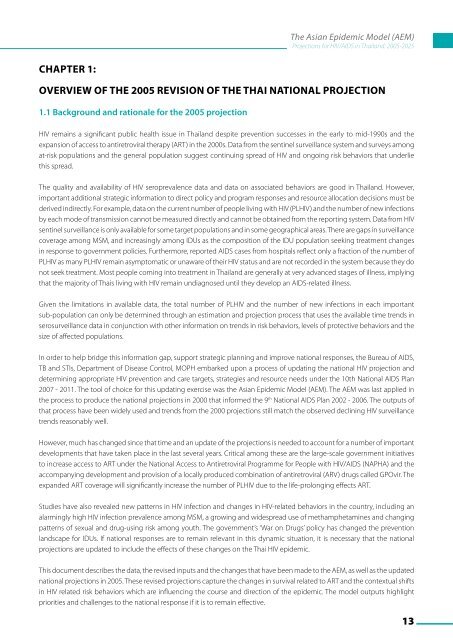The Asian Epidemic Model (AEM) Projections for ... - AIDS Data Hub
The Asian Epidemic Model (AEM) Projections for ... - AIDS Data Hub
The Asian Epidemic Model (AEM) Projections for ... - AIDS Data Hub
You also want an ePaper? Increase the reach of your titles
YUMPU automatically turns print PDFs into web optimized ePapers that Google loves.
<strong>The</strong> <strong>Asian</strong> <strong>Epidemic</strong> <strong>Model</strong> (<strong>AEM</strong>)<strong>Projections</strong> <strong>for</strong> HIV/<strong>AIDS</strong> in Thailand: 2005-2025CHAPTER 1:OVERVIEW OF THE 2005 REVISION OF THE THAI NATIONAL PROJECTION1.1 Background and rationale <strong>for</strong> the 2005 projectionHIV remains a significant public health issue in Thailand despite prevention successes in the early to mid-1990s and theexpansion of access to antiretroviral therapy (ART) in the 2000s. <strong>Data</strong> from the sentinel surveillance system and surveys amongat-risk populations and the general population suggest continuing spread of HIV and ongoing risk behaviors that underliethis spread.<strong>The</strong> quality and availability of HIV seroprevalence data and data on associated behaviors are good in Thailand. However,important additional strategic in<strong>for</strong>mation to direct policy and program responses and resource allocation decisions must bederived indirectly. For example, data on the current number of people living with HIV (PLHIV) and the number of new infectionsby each mode of transmission cannot be measured directly and cannot be obtained from the reporting system. <strong>Data</strong> from HIVsentinel surveillance is only available <strong>for</strong> some target populations and in some geographical areas. <strong>The</strong>re are gaps in surveillancecoverage among MSM, and increasingly among IDUs as the composition of the IDU population seeking treatment changesin response to government policies. Furthermore, reported <strong>AIDS</strong> cases from hospitals reflect only a fraction of the number ofPLHIV as many PLHIV remain asymptomatic or unaware of their HIV status and are not recorded in the system because they donot seek treatment. Most people coming into treatment in Thailand are generally at very advanced stages of illness, implyingthat the majority of Thais living with HIV remain undiagnosed until they develop an <strong>AIDS</strong>-related illness.Given the limitations in available data, the total number of PLHIV and the number of new infections in each importantsub-population can only be determined through an estimation and projection process that uses the available time trends inserosurveillance data in conjunction with other in<strong>for</strong>mation on trends in risk behaviors, levels of protective behaviors and thesize of affected populations.In order to help bridge this in<strong>for</strong>mation gap, support strategic planning and improve national responses, the Bureau of <strong>AIDS</strong>,TB and STIs, Department of Disease Control, MOPH embarked upon a process of updating the national HIV projection anddetermining appropriate HIV prevention and care targets, strategies and resource needs under the 10th National <strong>AIDS</strong> Plan2007 - 2011. <strong>The</strong> tool of choice <strong>for</strong> this updating exercise was the <strong>Asian</strong> <strong>Epidemic</strong> <strong>Model</strong> (<strong>AEM</strong>). <strong>The</strong> <strong>AEM</strong> was last applied inthe process to produce the national projections in 2000 that in<strong>for</strong>med the 9 th National <strong>AIDS</strong> Plan 2002 - 2006. <strong>The</strong> outputs ofthat process have been widely used and trends from the 2000 projections still match the observed declining HIV surveillancetrends reasonably well.However, much has changed since that time and an update of the projections is needed to account <strong>for</strong> a number of importantdevelopments that have taken place in the last several years. Critical among these are the large-scale government initiativesto increase access to ART under the National Access to Antiretroviral Programme <strong>for</strong> People with HIV/<strong>AIDS</strong> (NAPHA) and theaccompanying development and provision of a locally produced combination of antiretroviral (ARV) drugs called GPOvir. <strong>The</strong>expanded ART coverage will significantly increase the number of PLHIV due to the life-prolonging effects ART.Studies have also revealed new patterns in HIV infection and changes in HIV-related behaviors in the country, including analarmingly high HIV infection prevalence among MSM, a growing and widespread use of methamphetamines and changingpatterns of sexual and drug-using risk among youth. <strong>The</strong> government’s ‘War on Drugs’ policy has changed the preventionlandscape <strong>for</strong> IDUs. If national responses are to remain relevant in this dynamic situation, it is necessary that the nationalprojections are updated to include the effects of these changes on the Thai HIV epidemic.This document describes the data, the revised inputs and the changes that have been made to the <strong>AEM</strong>, as well as the updatednational projections in 2005. <strong>The</strong>se revised projections capture the changes in survival related to ART and the contextual shiftsin HIV related risk behaviors which are influencing the course and direction of the epidemic. <strong>The</strong> model outputs highlightpriorities and challenges to the national response if it is to remain effective.13















